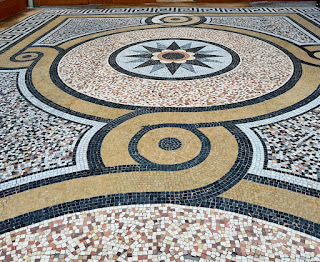 |
| Norman half-timered house, Cabourg, France |
Every year toward the end of our stay in Paris, we visit friends who have a horse farm in Normandy. After an hour or so of driving, the highway gives way to narrow roads that wind their way through a verdant rolling countryside. We are headed for a minuscule village that you are unlikely to find on anyone's must-visit tourist list. Over the years, however, we have come to love this little corner of Normandy and look forward to each visit. In past years, we've hiked, biked, rode horses, seen the famous 11th-century tapestry of Bayeaux, and visited the perfectly preserved medieval chateau of Crèvecoeur.
Located in the Calvados region of Normandy, the town has a beautiful XVI-century chateau that is designated a national monument, and a XV-century church that is relatively large for a small rural town. The chateau is privately owned, however, and can't be visited. The church can be viewed only from the exterior and recently the mechanism of its church bell stopped working. Town funds are scarce, but most of the 250 villagers agree that a town church without a bell is unacceptable, so it is hoped that before too long, the bells will once again peal.
Although lacking in big tourist attractions, the immediate area is full of beautiful half-timbered Norman houses and world-famous horse stables. Its apple orchards produce the region's distinct Calvados apple brandy, and its rich fields nourish the Norman cows, whose milk gives the bold earthy flavor to its indomitable Camembert cheese. The sea, less than an hour away, provides a plethora of fresh fish and shellfish.
Cave paintings and megaliths attest to prehistoric settlements that were subsequently peopled by Celtic, Roman, and Germanic tribes. Present-day Normandy, whose name means "country of the Northmen," dates back to the Viking invasion in the middle of the ninth century.
.jpeg) |
| Edgar Degas, Avant le départ, Musée d'Orsay, Paris |
For a more active sport, you can go to Deauville and take in a polo match. Invented about 2,500 years ago on the Persian steppes, polo is thought to be the world's oldest team sport. Polo's predecessor, known as buskashi, is still played today in places such as Uzbekistan. It is not a spectator sport for the faint of heart since it involves dozens of contestants furiously battling each other in an attempt to drag a dead, headless goat across a goal line.
 |
| Indoor polo match, Saint-Arnoult, France |
For non-horse people, Deauville also has miles of wide sandy beaches, a 1920s boardwalk, casinos, restaurants, and belle epoch villas.
Our visit this year was to Cabourg, which has many of the same seaside attractions as Deauville. The one notable exception is that Cabourg is the town where the great French writer Marcel Proust vacationed every summer. Even if you have never heard of Proust, you will know a lot about him after a visit to Cabourg. There are statues and informational plaques all over the town.
 |
| Dunes of Cap Cabourg, France |
We ended our stay in Cabourg with a long, brisk walk along the Promenade Proust and into the Dunes of Cap Cabourg, where, like Proust, we were "on all sides surrounded by images of the sea."
To see more photos, click here.
À bientôt,
Geraldine
In medieval dress at chateau of Crèvecoeur.
Note: Many towns in Normandy can be reached in two hours or less on frequent trains from Paris.
Photos unless otherwise noted by Geraldine Calisti Kaylor














